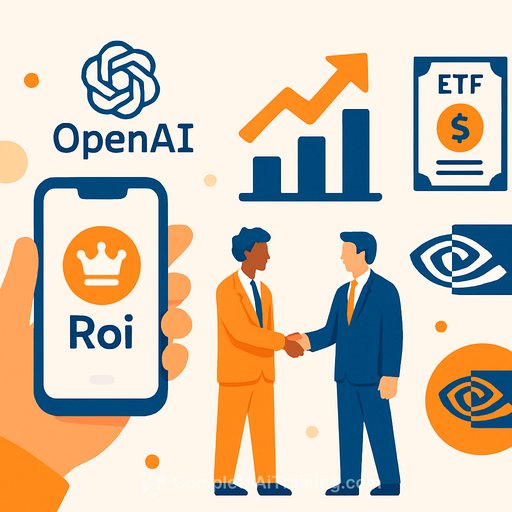OpenAI acquires finance app Roi: signals on personalization, product velocity, and compute scale
OpenAI has acquired Roi, an AI-powered finance app focused on personalization in consumer finance. Terms were not disclosed. Roi will end service to customers on October 15, and the New York-based startup had raised $3.6 million from investors including Balaji Srinivasan, Spark Capital, Gradient Ventures, and Spacecadet Ventures.
The move points to a clear priority: applying AI to spending insights, categorization, and context-aware recommendations at scale. For banks and fintechs, expect stronger AI assistants that can summarize financial behavior, forecast cash flow, and route users to higher-conversion actions across credit, savings, and investments.
Acquihire momentum and product experimentation
This deal follows recent acquihires by OpenAI, including Context.ai, Crossing Minds, and Alex. OpenAI also announced an all-stock acquisition of Statsig at a reported $1.1 billion valuation - a company known for experimentation platforms, feature flags, and rapid product iteration.
- Why it matters for finance teams: Personalization and experimentation capabilities tend to improve onboarding, reduce drop-off, and increase lifetime value. They also enable faster risk and compliance testing across cohorts before broad rollout.
- What to expect next: Tighter loops between model improvements, feature testing, and user-level targeting - with measurable impact on unit economics for consumer finance products.
OpenAI's financial posture
Reports indicate OpenAI's valuation is around $500 billion following a secondary sale, with $4.3 billion in revenue in the first half of 2025 and ARR rising from $10 billion in June to $13 billion, with expectations to exceed $20 billion by year-end. This signals ample capacity for continued hiring, M&A, and infrastructure expansion.
For finance leaders, that means more frequent product updates, deeper enterprise offerings, and potential pricing shifts as model performance and distribution scale. Budgeting for AI line items should assume faster release cycles and broader integration into analytics, underwriting, and customer support.
Compute scale: Nvidia deal and 10 GW data centers
A reported $100 billion agreement with Nvidia would deploy at least 10 GW of AI data centers equipped with millions of GPUs for OpenAI's next-gen infrastructure. If executed as reported, this will expand training capacity and stabilize inference supply, lowering risk of capacity bottlenecks for enterprise workloads.
- Planning implications for banks and fintechs: Negotiate GPU-backed capacity guarantees with cloud partners, assess latency and data residency for regulated workloads, and create a multi-model strategy to avoid single-vendor exposure.
- Cost outlook: Expect variable pricing tied to model size and throughput. Build cost models that separate training, fine-tuning, and high-volume inference, with clear thresholds for on-demand vs. reserved capacity.
What finance teams should do now
- Scope a PFM/assistant roadmap: spend categorization, merchant enrichment, cash flow forecasting, and personalized nudges tied to product funnels.
- Adopt experimentation at scale: integrate feature flags and guardrailed A/B testing before rolling out model-driven changes to broad segments.
- Tighten data governance: reinforce PII minimization, retention policies, and audit trails across model training, fine-tuning, and inference.
- Model evaluation: benchmark accuracy, calibration, and bias across cohorts; define SLAs for hallucination control and human-in-the-loop escalation.
- Budget with clarity: split spend across experimentation, production inference, and vendor data egress - then set ROI thresholds by product line.
- Upskill teams: enable product, risk, and compliance to work with LLM-native workflows and evaluation frameworks.
Roi shutdown: customer impact
Roi's service winds down on October 15. Current users should export data and review any linked-account permissions, especially for aggregator tokens, to ensure access is revoked and records are retained per policy.
For background on OpenAI's platform and roadmap, see the company site: OpenAI. For experimentation frameworks relevant to product teams, review Statsig.
Helpful resource
For a curated view of finance-focused AI tools and training, explore: AI tools for finance.
Your membership also unlocks:






